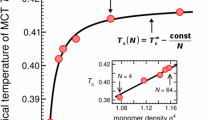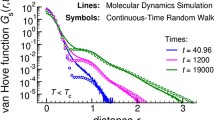Abstract
We examine by molecular dynamics simulations the relaxation of polymer-solvent mixtures close to the glass transition. The simulations employ a coarse-grained model in which polymers are represented by bead-spring chains and solvent particles by monomers. The interaction parameters between polymer and solvent are adjusted such that mixing is favored. We find that the mixtures have one glass transition temperature T g or critical temperature T c of mode-coupling theory (MCT). Both T g and T c (> T g decrease with increasing solvent concentration \( \phi_{{{\rm S}}}^{}\). The decrease is linear for the concentrations studied (up to \( \phi_{{{\rm S}}}^{}\) = 25%. Above T c we explore the structure and relaxation of the polymer-solvent mixtures on cooling. We find that, if the polymer solution is compared to the pure polymer melt at the same T, local spatial correlations on the length scale of the first peak of the static structure factor S(q) are reduced. This difference between melt and solution is largely removed when comparing the S(q) of both systems at similar distance to the respective T c. Near T c we investigate dynamic correlation functions, such as the incoherent intermediate scattering function \( \phi_{q}^{{{\rm s}}}\)(t), mean-square displacements of the monomers and solvent particles, two non-Gaussian parameters, and the probability distribution P(ln r;t) of the logarithm of single-particle displacements. In accordance with MCT we find, for instance, that \( \phi_{q}^{{{\rm s}}}\)(t) obeys the time-temperature superposition principle and has \( \alpha\) relaxation times \( \tau_{q}^{{{\rm s}}}\) which are compatible with a power law increase close (but not too close) to T c. In divergence to MCT, however, the increase of \( \tau_{q}^{{{\rm s}}}\) depends on the wavelength q, small q values having weaker increase than large ones. This decoupling of local and large-length scale relaxation could be related to the emergence of dynamic heterogeneity at low T. In the time window of the \( \alpha\) relaxation an analysis of P(ln r;t) reveals a double-peak structure close to T c. The first peak correponds to “slow” particles (monomer or solvent) which have not moved much farther than 10% of their diameter in time t, whereas the second occurs at distances of the order of the particle diameter. These “fast” particles have succeeded in leaving their nearest-neighbor cage in time t. The simulation thus demonstrates that large fluctuations in particle mobility accompany the final structural relaxation of the cold polymer solution in the vicinity of the extrapolated T c.
Similar content being viewed by others
References
J. Ferry, Viscoelastic Properties of Polymers (Wiley, New York, 1980).
G.B. McKenna, in Comprehensive Polymer Science, edited by C. Booth, C. Price, Vol. 2 (Pergamon, New York, 1986) pp. 311--362.
More precisely, plasticization of the polymer means that the solvent does not only decrease $T_{\ab{g}}$, but also softens the polymer glass by reducing the elastic moduli ferry. Besides this normally encountered case, there are also systems in which the solvent “antiplasticizes” the polymer. That is, the solvent decreases $T_{\ab{g}}$, but increases the elastic moduli of the polymer glass. The origin of this antiplasticizing effect has recently been studied by simulations for both bulk systems and polymer films RigglemanEtal:PRL2006,RigglemanEtal:PRE2007.
T.S. Chow, Macromolecules 13, 362 (1980).
J.E.G. Lipson, S.T. Milner, J. Polym. Sci. Part B 44, 3528 (2006).
T.P. Lodge, T.C.B. McLeish, Macromolecules 33, 5278 (2000).
G. Foffi, W. Götze, F. Sciortino, P. Tartaglia, T. Voigt\-mann, Phys. Rev. E 69, 011505 (2004).
U.K. Rößler, H. Teichler, Phys. Rev. E 61, 394 (2000).
A.J. Moreno, J. Colmenero, Phys. Rev. E 74, 021409 (2006).
A.J. Moreno, J. Colmenero, J. Chem. Phys. 124, 184906 (2006).
A.J. Moreno, J. Colmenero, J. Phys.: Condens. Matter 19, 466112 (2007).
W. Götze, T. Voigtmann, Phys. Rev. E 67, 021502 (2003).
W.C.K. Poon, J. Phys.: Condens. Matter 14, R859 (2002).
A.M. Puertas, M. Fuchs, M.E. Cates, Phys. Rev. Lett. 88, 098301 (2002).
K. Dawson, G. Foffi, M. Fuchs, W. Götze, F. Sciortino, M. Sperl, P. Tartaglia, T. Voigtmann, E. Zaccarelli, Phys. Rev. E 63, 011401 (2000).
W. Götze, J. Phys.: Condens. Matter 11, A1 (1999).
W. Kob, J. Phys.: Condens. Matter 11, R85 (1999).
K.S. Schweizer, Curr. Opin. Colloid Interface Sci. 12, 297 (2007).
J. Baschnagel, F. Varnik, J. Phys.: Condens. Matter 17, R851 (2005).
J. Colmenero, A. Arbe, Soft Matter 3, 1474 (2007).
R.A.L. Vallée, M. Van der Auweraer, W. Paul, K. Binder, Phys. Rev. Lett. 97, 217801 (2006).
R.A.L. Vallée, W. Paul, K. Binder, J. Chem. Phys. 127, 154903 (2007).
J.V. Heffernan, J. Budzien, A.T. Wilson, R.J. Baca, V.J. Aston, F. Avila, J.D. McCoy, D.B. Adolf, J. Chem. Phys. 126, 184904 (2007).
R.A. Riggleman, K. Yoshimoto, J.F. Douglas, J.J. de Pablo, Phys. Rev. Lett. 97, 045502 (2006).
R.A. Riggleman, J.F. Douglas, J.J. de Pablo, Phys. Rev. E 76, 011504 (2007).
S. Peter, H. Meyer, J. Baschnagel, J. Polym. Sci. B 44, 2951 (2006).
S. Peter, H. Meyer, J. Baschnagel, R. Seemann, J. Phys.: Condens. Matter 19, 205119 (2007).
S. Peter, S. Napolitano, H. Meyer, M. Wübbenhorst, J. Baschnagel, to be published in Macromolecules.
K. Kremer, G.S. Grest, J. Chem. Phys. 92, 5057 (1990).
M. Pütz, K. Kremer, G.S. Grest, Europhys. Lett. 49, 735 (2000), see also the Comment and Reply in Europhys. Lett. 52, 719 (2000)
K. Binder, J. Horbach, W. Kob, W. Paul, F. Varnik, J. Phys.: Condens. Matter 16, S429 (2004).
T. Soddemann, B. Dünweg, K. Kremer, Phys. Rev. E 68, 046702 (2003).
J. Buchholz, W. Paul, F. Varnik, K. Binder, J. Chem. Phys. 117, 7364 (2002).
S.-H. Chong, M. Fuchs, Phys. Rev. Lett. 88, 185702 (2002).
S.-H. Chong, M. Aichele, H. Meyer, M. Fuchs, J. Baschnagel, Phys. Rev. E 76, 051806 (2007).
M. Rubinstein, R.H. Colby, Polymer Physics (Oxford University Press, Oxford, 2003).
M. Doi, S.F. Edwards, The Theory of Polymer Dynamics (Oxford University Press, Oxford, 1986).
E. Flenner, G. Szamel, Phys. Rev. E 72, 011205 (2005).
E. Flenner, G. Szamel, Phys. Rev. E 72, 031508 (2005).
W. Götze, Condens. Matter Phys. 1, 873 (1998).
W. Götze, in Proceedings of the Les Houches Summer School of Theoretical Physics, Les Houches 1989, Session LI, edited by J.P. Hansen, D. Levesque, J. Zinn-Justin (North-Holland, Amsterdam, 1991) pp. 287--503.
T. Franosch, M. Fuchs, W. Götze, M.R. Mayr, A.P. Singh, Phys. Rev. E 55, 7153 (1997).
M. Fuchs, W. Götze, M.R. Mayr, Phys. Rev. E 58, 3384 (1998).
A. Rinaldi, F. Sciortino, P. Tartaglia, Phys. Rev. E 63, 061210 (2001).
T. Voigtmann, A.M. Puertas, M. Fuchs, Phys. Rev. E 70, 061506 (2004).
W. Götze, T. Voigtmann, Phys. Rev. E 61, 4133 (2000).
C.Z.-W. Liu, I. Oppenheim, Physica A 235, 369 (1997).
M. Fuchs, I. Hofacker, A. Latz, Phys. Rev. A 45, 898 (1992).
M. Fuchs, J. Non-Cryst. Solids 172-174, 241 (1994).
W. Kob, in Slow relaxations and nonequilibrium dynamics in condensed matter, edited by J.-L. Barrat, M. Feigelmann, J. Kurchan, J. Dalibard (EDP Sciences/Springer, Les Ulis/Berlin, 2003) pp. 201--269.
P. Chaudhuri, L. Berthier, W. Kob, Phys. Rev. Lett. 99, 060604 (2007).
H. Sillescu, J. Non-Cryst. Solids 243, 81 (1999).
M.D. Ediger, Annu. Rev. Phys. Chem. 51, 99 (2000).
S.C. Glotzer, J. Non-Cryst. Solids 274, 342 (2000).
R. Richert, J. Phys.: Condens. Matter 14, R703 (2002).
L. Berthier, G. Biroli, J.-P. Bouchaud, W. Kob, K. Miyazaki, D.R. Reichman, J. Chem. Phys. 126, 184503 (2007).
L. Berthier, G. Biroli, J.-P. Bouchaud, W. Kob, K. Miyazaki, D.R. Reichman, J. Chem. Phys. 126, 184504 (2007).
J.P. Hansen, I.R. McDonald, Theory of Simple Liquids (Academic Press, London, 1986).
A.M. Puertas, M. Fuchs, M.E. Cates, J. Chem. Phys. 121 (2004).
M. Aichele, Y. Gebremichael, F.W. Starr, J. Baschnagel, S.C. Glotzer, J. Chem. Phys. 119, 5290 (2003), publisher’s note: J. Chem. Phys. 120, 6798 (2004).
K. Binder, M. Müller, P. Virnau, L.G. MacDowell, Adv. Polym. Sci. 173, 1 (2005).
M. Müller, G.D. Smith, J. Polym. Sci.: Part B 43, 934 (2005).
P. Virnau, M. Müller, L. Gonzalez MacDowell, K. Binder, Comput. Phys. Commun. 147, 378 (2002).
P. Virnau, M. Müller, L.G. MacDowell, K. Binder, J. Chem. Phys. 121, 2169 (2004).
L. Yelash, M. Müller, W. Paul, K. Binder, J. Chem. Phys. 123, 14908 (2005).
M. de Podesta, Understanding the Properties of Matter (CRC Press, 2002).
D. Long, F. Lequeux, Eur. Phys. J. E 4, 371 (2001).
L. González MacDowell, M. Müller, C. Vega, K. Binder, J. Chem. Phys. 113, 419 (2002).
K.S. Schweizer, E.J. Saltzman, J. Chem. Phys. 121, 1984 (2004).
Author information
Authors and Affiliations
Corresponding author
Rights and permissions
About this article
Cite this article
Peter, S., Meyer, H. & Baschnagel, J. MD simulation of concentrated polymer solutions: Structural relaxation near the glass transition. Eur. Phys. J. E 28, 147–158 (2009). https://doi.org/10.1140/epje/i2008-10372-9
Received:
Published:
Issue Date:
DOI: https://doi.org/10.1140/epje/i2008-10372-9




